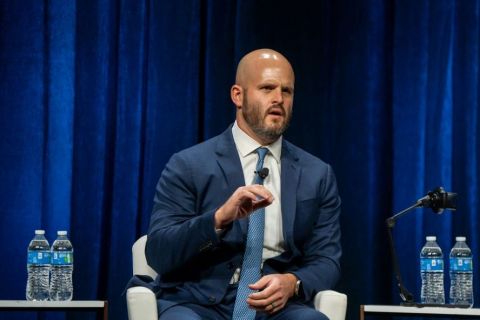During the past several years, the industry has witnessed an increase in private-equity-backed companies entering the midstream due to attractive prices for acquisitions and greenfield projects. However, most of these companies have focused on the Marcellus and Haynesville because of the proliferation of activity in those two plays.
As producers have switched their focus to liquids-rich plays, such as the Eagle Ford and Bakken shale, midstream companies have begun to focus on these same regions. One of these midstream companies is Bear Tracker Energy LLC, backed by GSO Capital. Bear Tracker is primarily hunting for opportunities in the Rocky Mountain region, and with good reason.
"Our entire team has most of their experience in the Rockies over the past 20 to 30 years," explains Dave Keanini, president and chief operating officer of Bear Tracker.

“Just about all of the gas out of the Rockies needs to be processed, and a significant amount needs to be treated for CO2 or H2S removal, as well.” Dave Keanini, president and chief operating officer, Bear Tracker Energy LLC
With some 25 years of experience, most recently as general manager of Rockies Midstream for Anadarko Petroleum Corp., Keanini oversaw a variety of operations, including engineering and business development, for more than 25 facilities. He was a vice president for Western Gas Resources and now serves as director for the Wyoming Pipeline Authority.
Bear Tracker was formed by chairman and chief executive Robert J. Clark, who has more than 40 years experience in the energy sector and was the former president and chief executive of two midstream start-ups, Bear Paw Energy LLC and Bear Cub Energy LLC.
Bear Paw Energy had three processing facilities in North Dakota (total aggregated nameplate capacity of more than 100 million cubic feet of gas per day) and a smaller one in Montana. Bear Paw sold those facilities to Northern Border, an Enron company. Although the four facilities were later acquired by Oneok Inc., the four facilities continue to be known as Bear Paw Energy.
While at the helm of both companies, Clark generated a 317% (Bear Paw Energy) and 27% (Bear Cub Energy) internal rate of return, respectively. Prior to Bear Paw and Bear Cub, Clark was a senior officer with Snyder Oil Corp., Ladd Petroleum Corp., and Nicor Inc.
"I was very aware of Bob Clark's history and his reputation in the business," says Keanini. "He's a high-intensity guy, so our values match up, and I also like the idea of having a chance to successfully grow a new company from the beginning into something with a lot of value for our shareholders." And where else to create value than in a growing play in the Rockies?
Bakken project
"We really like the Bakken because it's so active, and we think we can be very competitive with some of the other midstream companies there based on our experience. We know who most of the players are, where the fields are, so that's our main focus—to look for deals in the Rockies," he says.
The company recently set its sights on its first project—a gathering system in the Bakken. Bear Tracker has already signed a definitive agreement with a "large U.S. independent oil and natural gas E&P company" to build, own, operate and expand a gas-gathering system in the play, says Keanini. Now it's time to execute the plan.
"The system itself will consist of gathering at the wellhead in up to 18 townships with five compressor stations initially. The ultimate capacity is being designed to accommodate some third-party gas in addition to the expected production from the base system. We're building it to be flexible enough so that, with additional compression in key spots, we can double its initial capacity," he says.
The gas gathered from this initial producer, which the company declined to name due to contract terms, is dedicated to an existing gas-processing plant. As more third parties are added to the system, Bear Tracker could build its own processing plant for the third-party volume, once it reaches a certain capacity.
"Processing is one of our areas of expertise, so it's something we'd be very interested in," Keanini says.
This gathering system and the proposed processing plant reflect the company's primary focus, which will be greenfield projects. However, Keanini says the company would consider strategic acquisitions if attractive possibilities appear on its radar.
"We're primarily looking at greenfield projects, but if the right deals come along we'll look at them. It's not a bad time to be looking for gas assets in the current gas-price environment. Our view is that gas is going to turn around, whether it's this year or three years from now."
Strategic acquisitions that would interest Bear Tracker include distressed assets in regions where producers have pulled their rigs, but where a history of gas production with lots of gas left to produce exists, such as in Wyoming, Utah and parts of Colorado.

Town officials in Williston, North Dakota, freely hand out bumper stickers promoting the Bakken boom.
Financial backing
Bear Tracker Energy is backed by a $200-million initial commitment from GSO Capital, but Keanini says that this figure is just a starting point for GSO's capital investment into Bear Tracker.
"We want to get to a point where they have invested all of that funding. We'd like to get to the $500 million or more invested capital range in the next five years, which may not be all GSO. We would likely add some debt to get to a healthy balance of debt and equity," he says.
Although the company has a relatively small staff, Keanini says it is nimble and has the capability to take on more projects while working on the Bakken gathering system.
"It really depends on the size and magnitude of the projects, but we have the capacity to take on more than this one. Because of the way that we're leveraging a lot of the design engineering, we could take on another project of this size by adding very minimal staff," he says.
Bear Tracker's capability to do design and engineering work inhouse also provides an advantage over other companies, as it can reduce costs by not farming this work out.
In addition, Bear Tracker will do all of its own marketing on the liquids side through its vice president of marketing, Chip Duval.
Duval has been in the oil and gas industry for 30 years. Before Bear Tracker, he was president of Lodgepole Energy Marketing and manager of wholesale marketing for TransMontaigne Product Services Inc. Other positions include marketing roles for EOTT Energy, Giant Refining Inc. and Asamera Oil Co.
"Chip is a real expert on North Dakota and NGL marketing. With him on board, I think we'll do very well on the marketing side, which will also serve as a meaningful competitive advantage, compared to what other people might be able to do," Keanini says.
This marketing isn't likely to include its own liquids, as the company will try to focus on fee-based deals with producers. But Keanini says that the nature of the midstream business does require some amount of percent-of-proceeds (POP) deals in which Bear Tracker would technically have to market its own product.
"We know that in order to grow the company, it is unlikely that we'll be able to stay 100% with fee-based deals and there will need to be some POP deals. For the most part, we're going to go after straight-fee deals to lessen our exposure to commodity prices. Then, as we grow, we'll add more POP to give us the chance to participate in more of the upside as well."

A fresh-caught sample shows the high quality of Bakken crude.
Seeking opportunities
Although the company is initially focusing on the liquids-rich Bakken shale, which it views as a subset of the Rockies, Keanini anticipates that, due to the nature of gas in the Rockies, it will focus on processing, treating and pipeline projects in the region.
"Just about all of the gas out of the Rockies needs to be processed, and a significant amount needs to be treated for CO2 and H2S, as well."
Despite the Rockies being the company's main focus, Keanini says that Bear Tracker will also look elsewhere to develop projects. Although it is probably too late to enter the Marcellus or Eagle Ford, Keanini says the Niobrara is a target for the company.
"Producers are going to figure out how to get volumes out of that play consistently, and I think they're going to figure it out this year. I think we can be one of the first-movers in the play on the gathering side."
Keanini says that while some industry observers think that the end of the big plays is near, he's not so sure. While numerous large new plays are unlikely to be discovered, technology will likely keep opening up production on fields long since given up by producers.
"What I've learned is that just when you think a field is rolling over on production, because you've recovered all you're going to recover, technology comes along and changes that notion. The Bakken is an old field that everyone thought was done, and now here we are back again because of technology. You may not see a brand new play in a brand new area, but they're going to figure out ways based on technology to keep the boom going," he says.
Recommended Reading
Riley Permian Announces Quarterly Dividend
2024-04-11 - Riley Exploration Permian’s dividend is payable May 9 to stockholders of record by April 25.
TechnipFMC Eyes $30B in Subsea Orders by 2025
2024-02-23 - TechnipFMC is capitalizing on an industry shift in spending to offshore projects from land projects.
Baker Hughes Awarded Saudi Pipeline Technology Contract
2024-04-23 - Baker Hughes will supply centrifugal compressors for Saudi Arabia’s new pipeline system, which aims to increase gas distribution across the kingdom and reduce carbon emissions
Patterson-UTI Braces for Activity ‘Pause’ After E&P Consolidations
2024-02-19 - Patterson-UTI saw net income rebound from 2022 and CEO Andy Hendricks says the company is well positioned following a wave of E&P consolidations that may slow activity.
ProPetro Reports Material Weakness in Financial Reporting Controls
2024-03-14 - ProPetro identified a material weakness in internal controls over financial reporting, the oilfield services firm said in a filing.





